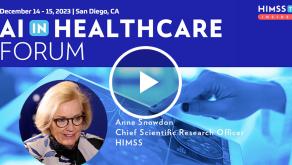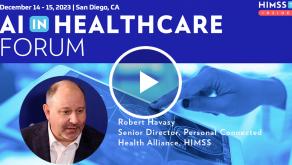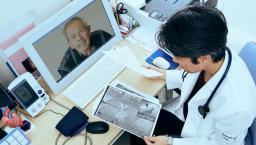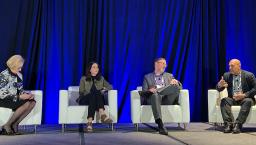The new nursing challenge: Adapting to AI-enabled workflows for quality improvement

Jung In Park, associate professor at the University of California Irvine School of Nursing
Photo: Jung In Park
The healthcare AI market is expected to grow by 37% annually until 2030. While only one-fifth of healthcare organizations worldwide were adopting AI models as of 2021, there is growing opportunity and pressure to use AI's capabilities to advance patient care and medicine.
As the industry changes, one way nurses are having to adapt is becoming increasingly tech savvy.
The University of California Irvine’s Sue & Bill Gross School of Nursing is a trailblazer in using artificial intelligence and machine learning to improve care. Jung In Park is an associate professor at the university. She holds a PhD in nursing informatics from the University of Minnesota and a bachelor's degree in nursing from Seoul National University.
She is an expert in healthcare technology, working to improve care and health outcomes using machine learning. She also helps current and future nurses be best equipped to use new technologies.
Healthcare IT News sat down with Park to discuss how Irvine's school of nursing is using AI and machine learning, where in healthcare delivery she and her team are applying AI, how the application of AI is improving patient outcomes, and her plans to use large language models and generative AI.
Q. What is the University of California Irvine School of Nursing doing to further the use of artificial intelligence and machine learning by nurses? What must nurses know about AI?
A. The Sue & Bill Gross School of Nursing at the University of California Irvine acknowledges the vast potential of informatics and artificial intelligence for nursing research and education. The emergence of informatics and data technology allows nurse researchers to focus on the utilization of AI and machine learning approaches using large data sets to gain new insights into quality nursing care.
The related domains of AI and wearable technology are paving the way for responsive and personalized treatments, offering the potential for advanced and sustainable care. We also emphasize collaboration with colleagues from various disciplines on campus as well as from the public and private sectors to further explore the expanding potential of these advancements.
In addition, we offer various levels of nursing informatics courses to students. Teaching nursing students about AI, machine learning and informatics is crucial because these technologies are increasingly integrated into healthcare, and nurses need to be prepared to effectively navigate and use them in their practice.
Understanding AI and machine learning empowers nurses to leverage data-driven insights, enhance patient care and adapt to the evolving technological landscape in healthcare. AI applications in healthcare are diverse, including diagnostics, personalized treatment planning, patient monitoring and operational efficiency by automating routine tasks.
Nurses should collaborate effectively with AI systems while maintaining their professional judgment and expertise. Thus, ongoing learning is essential to keeping up with AI advancements and ensuring their safe and effective use. With a solid understanding of AI, nurses can leverage its potential benefits to deliver high-quality, patient-centered care.
Q. Where in healthcare delivery and specifically in nursing is AI being applied? What are caregivers doing with the technology?
A. AI is revolutionizing various aspects of healthcare delivery. Specifically, I am using large health data sets, such as electronic health records, national cancer registries and sensor data from wearables, to develop machine learning models that predict various patient outcomes, including hospital-acquired infections, 30-day readmissions and survival rates.
In diagnostics and imaging, AI algorithms analyze medical images to detect abnormalities and enhance accuracy. Clinical decision support systems use AI to analyze patient data, aiding healthcare professionals in decision-making and reducing errors.
AI’s ability to analyze large data sets, including genomic information, enables precision medicine by tailoring treatments to individual patients. Remote patient monitoring through AI-enabled devices and wearables allows for proactive and personalized care. AI also streamlines administrative tasks, optimizes resource allocation and improves operational efficiency.
Additionally, AI-powered chatbots and virtual assistants provide round-the-clock access to healthcare information and support patient engagement.
The users of AI technology in healthcare encompass a wide range of healthcare providers, organizations and researchers. Physicians, nurses and radiologists use AI to enhance diagnostics, personalize treatments, individualize nursing care planning and optimize operations.
Healthcare organizations benefit from AI’s efficiency-improving capabilities and resource utilization. Researchers employ AI to analyze large data sets and drive advancements in healthcare. Overall, AI technology in healthcare delivery improves accuracy, efficiency and patient outcomes, leading to enhanced healthcare quality and increased patient satisfaction.
Q. How is the application of AI improving patient outcomes? What are other benefits?
A. The application of AI in healthcare is improving patient outcomes in several ways. AI algorithms analyze patient data, including medical images and electronic health records, to enhance diagnosis and early detection. This leads to more accurate and timely diagnoses, enabling prompt intervention and treatment initiation.
AI also enables personalized treatment plans by analyzing vast amounts of patient data, considering factors like genomic information, to tailor treatments to individual patients. This improves treatment effectiveness and reduces adverse effects. Additionally, AI systems provide evidence-based recommendations and insights to healthcare professionals, supporting their clinical decision-making process.
By identifying appropriate treatment options and predicting patient outcomes, AI reduces medical errors and enhances patient safety.
AI-enabled devices and wearables enable continuous remote monitoring of patients’ health indicators, allowing for early detection of changes or deterioration. This facilitates timely intervention, preventing adverse events and reducing hospital readmissions.
AI technology also streamlines workflow processes, automates administrative tasks, optimizes resource allocation and improves operational efficiency. This reduces the burden on healthcare professionals, allowing them to focus more on direct patient care and improving patient experiences and outcomes.
Q. Do you have plans to use large language models/generative AI? Why or why not?
A. Yes, I plan to use a large language model for predicting patient outcomes, specifically focusing on factors such as the risk of mortality and hospital-acquired conditions. This powerful model has the ability to comprehend and analyze unaltered text extracted from clinical notes within electronic health records, providing estimates relevant to patient care.
It can effectively process various types of clinical notes, encompassing radiology reports, nursing documentation, patient progress notes and discharge instructions, even when standardized language is absent. This capability allows the model to interpret unique abbreviations and terms that individual writers use.
The large language model operates by predicting the most appropriate word to complete a sentence, drawing on real-world language patterns. Over time, as more data are fed into the model, its predictive accuracy improves.
Leveraging this model can offer real-time support to healthcare providers’ clinical decision-making, alerting them to critical factors that may potentially lead to adverse events and provide valuable insights to healthcare professionals.
Follow Bill's HIT coverage on LinkedIn: Bill Siwicki
Email him: bsiwicki@himss.org
Healthcare IT News is a HIMSS Media publication.
























